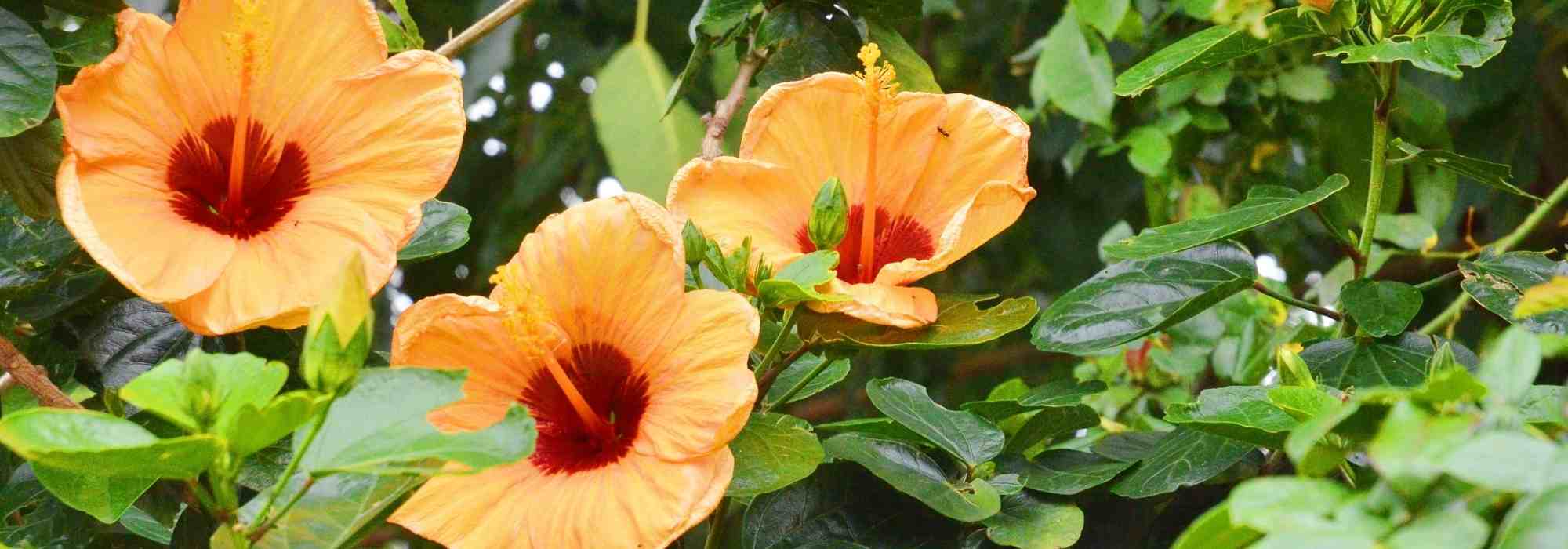
How to choose a hibiscus?
Buyer's guide and criteria to find the ideal hibiscus variety
Contents
Hibiscus are shrubs or perennial depending on species, summer-flowering of family Malvaceae. Easy to grow, they instantly add colour and a tropical touch to garden or indoors.
In our latitudes, two hibiscus species are grown outdoors: very hardy Hibiscus syriacus (also called Althéa, tree mallow or garden ketmie) and marsh hibiscus (moscheutos), which are grown with roots in water.
Indoors, Hibiscus rosa-sinensis steals the show, with large, showy, tropical-looking flowers.
So how to select hibiscus to suit your needs? According to colour palette and size of their flowers, flowering period, foliage, dimensions or specific growing requirements… Discover all characteristics to help you choose your hibiscus variety.
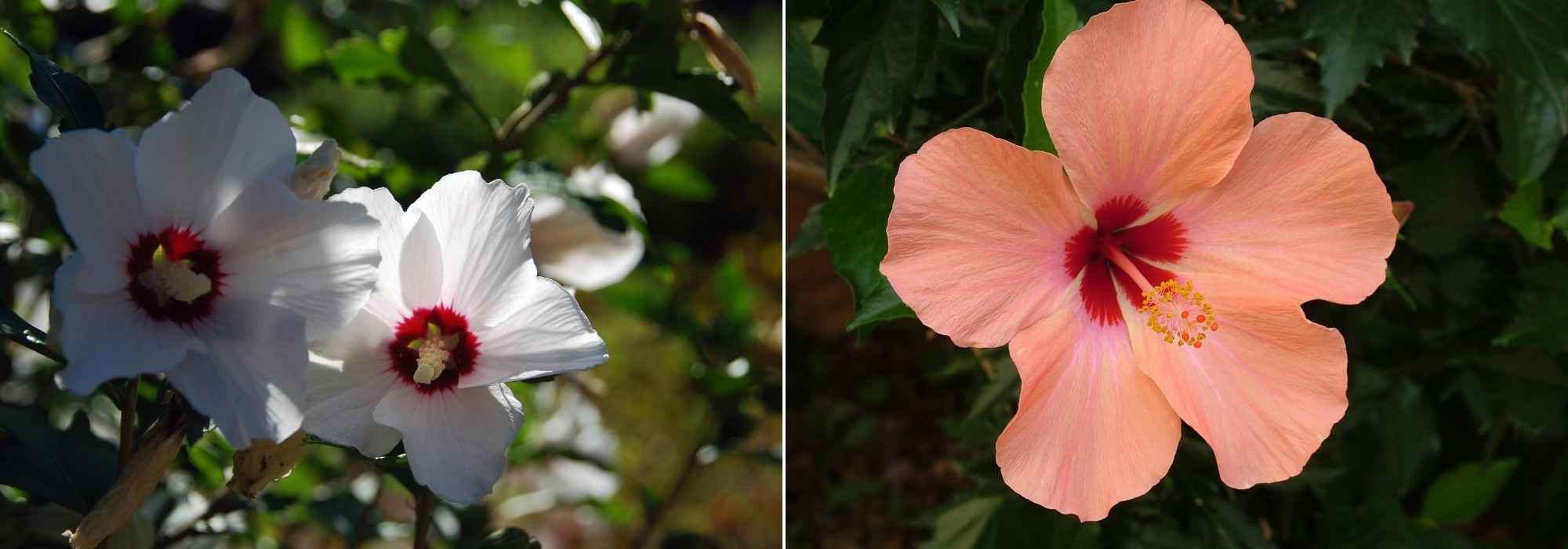
Hibiscus syriacus on left and Hibiscus moscheutos on right
Depending on the colour of their flowers
Although each flower is ephemeral and lasts only a single day, hibiscus offer renewed and almost uninterrupted flowering from July to October.
Their dazzling palette of colours ranges from pure white to deep purple, including bicolour varieties or those with contrasting centres.
White hibiscus
Single-coloured white hibiscus are delicate, refined varieties that bring a classic and romantic touch. Among them are Hibiscus syriacus ‘Totus Albus’ with single to semi-double flowers, ‘Eléonore’, a vigorous variety with large single 10 cm flowers, and ’White Chiffon’ with immaculate double flowers and a crumpled effect.
But other white hibiscus are adorned with a magnificent, explosive red centre:
- the Hibiscus syriacus ‘Speciosus’ with semi-double flowers;
- ‘Sup’Heart’ with large 12 cm flowers;
- the Hibiscus syriacus ‘French Point’ with large double crumpled flowers;
- ‘Lady Stanley’ with semi-double flowers revealing a ruffled centre;
- the Hibiscus syriacus ‘Shintaeyang’ with a centre splashed with cherry red.
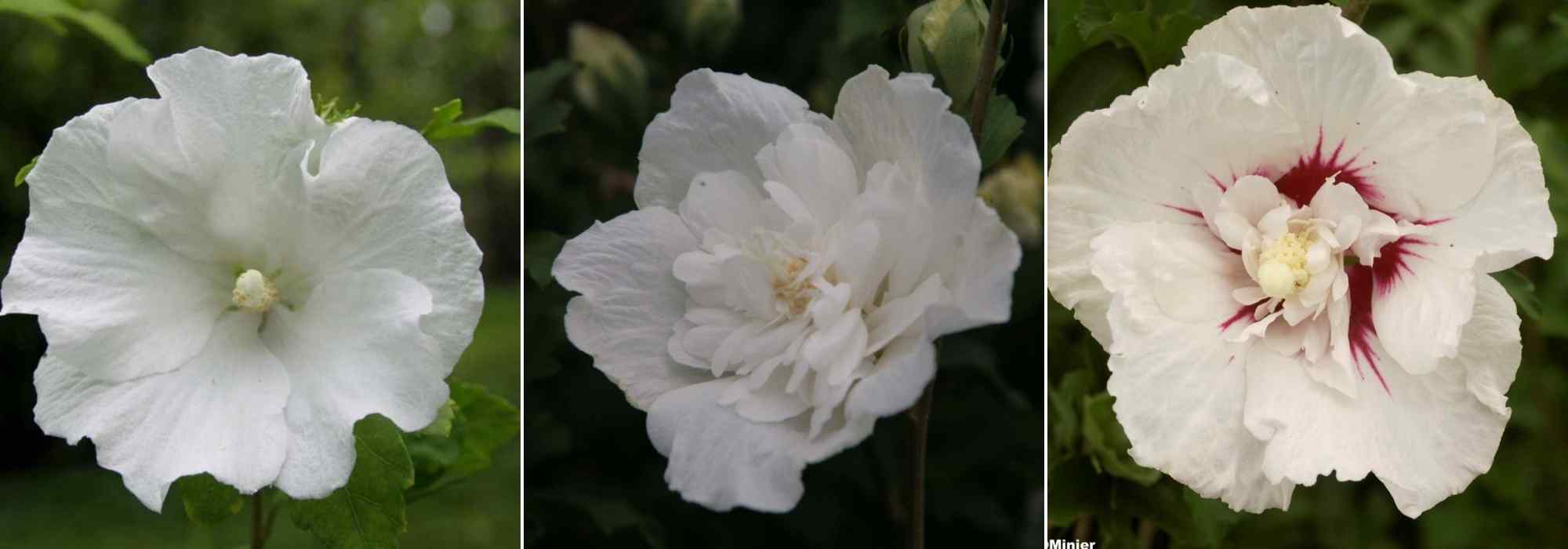
Hibiscus ‘Totus Albus’, ‘White Chiffon’ and ‘French Point’
→ Also read 5 white-flowering hibiscus
Blue and purple hibiscus
The hibiscus ‘French Cabaret Purple’ bears beautiful double violet flowers, resembling large pom-poms, while ‘Freedom’ produces double purple flowers.
The hibiscus ‘Oiseau Bleu’ in turn produces splendid blue-violet shaded flowers surrounding a beautiful red centre.
‘Ultramarine’ displays blue-lavender flowers with a centre striate with purple; ‘Summer Ruffle’ is a semi-double variety in mauve-pastel shades, surrounding a small crumpled red centre; the very refined ‘Blue Chiffon’ offers beautiful double flowers with a centre streaked with red.
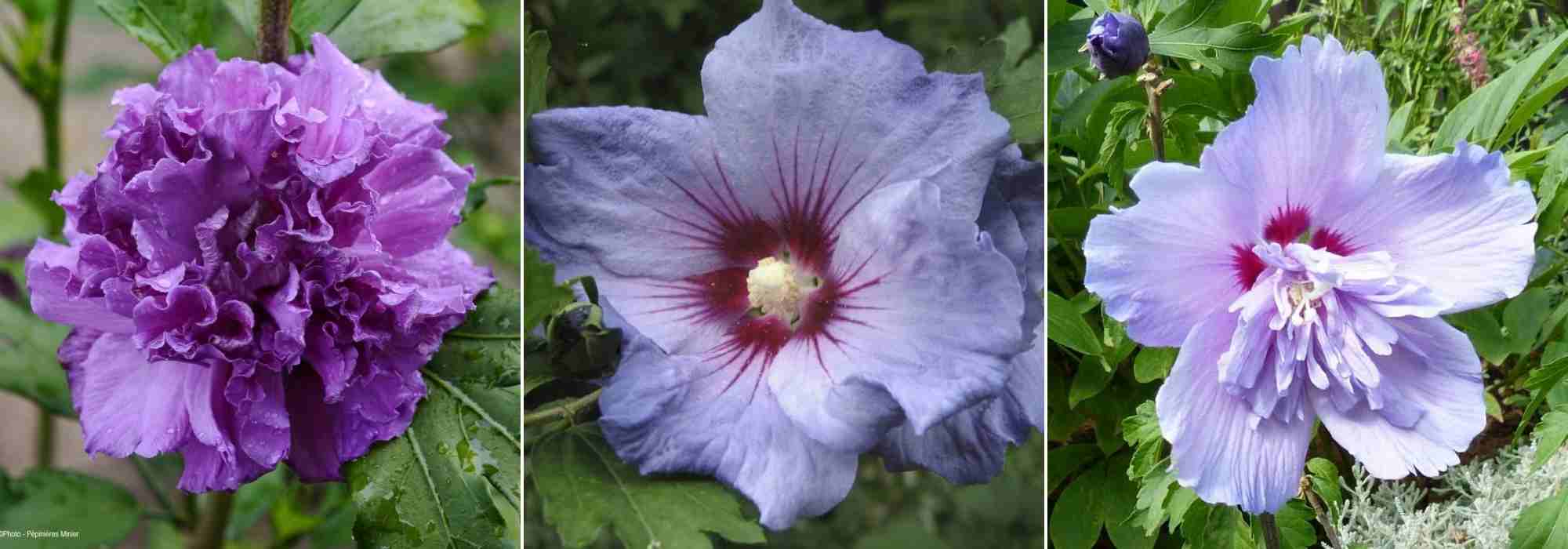
Hibiscus ‘French Cabaret’, ‘Oiseau Bleu’, and ‘Blue Chiffon’
Red hibiscus
It’s among marsh hibiscus that one finds hibiscus with brilliant red flowers: ‘Red Wine’ and ‘Midnight Marvel’ bear large 20 cm flowers of a dark red; the large flowers of ‘Planet Griotte Tangri’ tend towards cherry red, while the striking Hibiscus coccineus bears large, very graphic red flowers.
Among Hibiscus syriacus, note ‘French Cabaret Red’ and its adorable double red-magenta flowers.
→ Also read: 5 red-flowering hibiscus
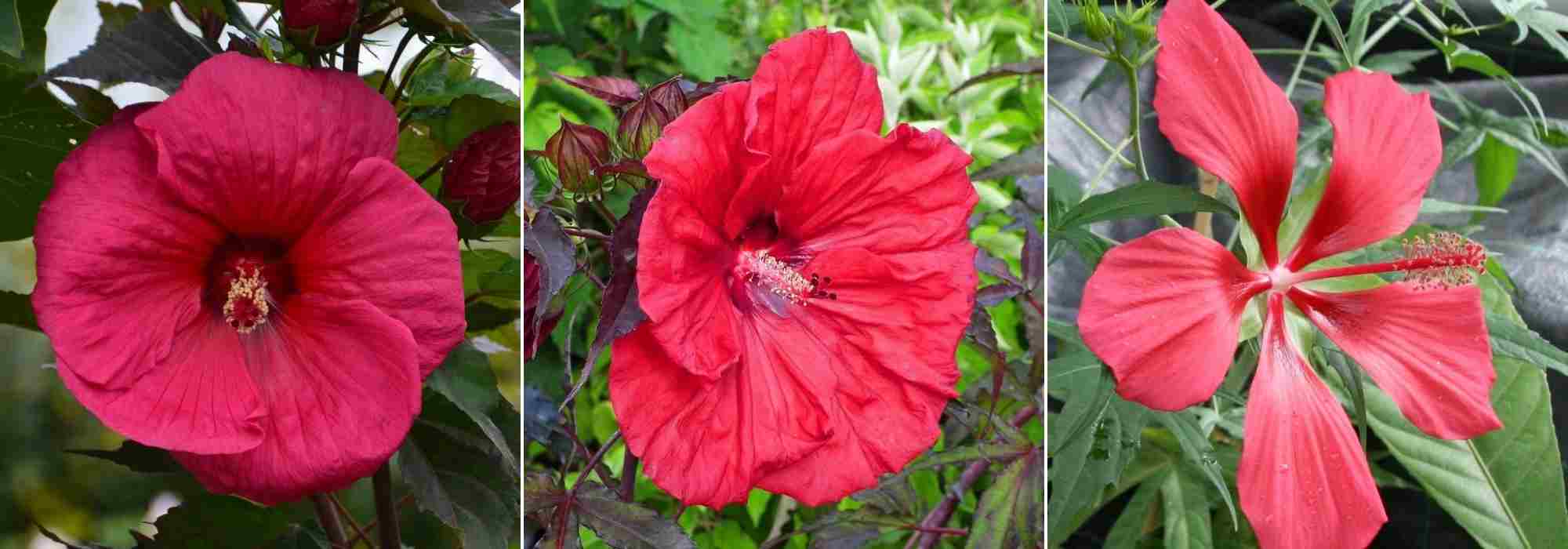
Hibiscus ‘Red Wine’, ‘Planet Griotte’, and Hibiscus coccineus
Pink hibiscus
Pink is one of the most widespread colours among hibiscus and comes in every shade:
- pale pink (‘Pink Chiffon’, ‘French Cabaret Pastel’)
- bright pink (Hibiscus moscheutos ‘Planet Solène Tansol’, Hibiscus syriacus ‘Woodbridge’)
- candy pink (Hibiscus moscheutos ‘Sweet Caroline’)
- pink leaning towards mauve or violet (‘Rose Moon’, ‘Lavender Chiffon’, ‘Freedom’, ‘Russian Violet’)
- pink leaning towards red (Hibiscus moscheutos ‘Pink Passion’)
- pink with a red centre (Hibiscus moscheutos ‘Pink Candy’ and ‘Sweet Caroline’, Hibiscus syriacus ‘Rose Moon’)
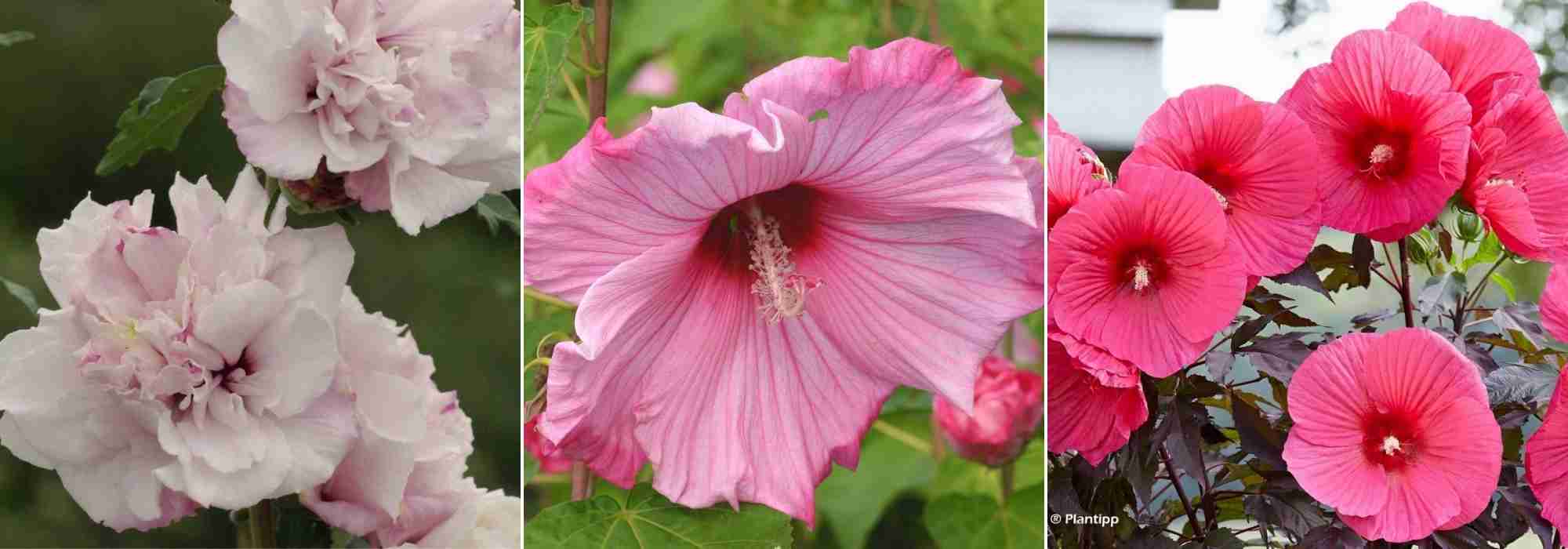
Hibiscus ‘French Cabaret’, ‘Sweet Caroline’, and ‘Pink Passion’
Bicolour hibiscus
Some hibiscus varieties sport two colours. This is the case with Hibiscus syriacus ‘Hamabo’ with white and pink petals spotted with purple, ‘Pinky Spot’ with semi-double crumpled white and pink flowers and a carmine-streaked centre, and the incredible ‘Starburst Chiffon’ with semi-double flowers whose pink petals are veined with carmine, surrounding a small, vividly crumpled centre.

Hibiscus syriacus ‘Hamabo’ and ‘Starbust Chiffon’
Depending on the shape of their flowers
Hibiscus flowers are shaped like corollas. They can be single or double and measure from 5 to more than 20 cm depending on variety.
Single-flowered hibiscus
Single-flowered hibiscus owe their charm to tropical cousin Hibiscus rosa sinensis, with bright colours and conspicuous stamens.
They bear five petals, sometimes recalling hollyhock flowers, such as ‘Shintaeyang’, ‘Ultramarine’, ‘Eleonore’, ‘Woodbridge’ or the delicate ‘Hamabo’.
Marsh hibiscus ‘Sweet Caroline’ also produces single flowers, with buds that open like roses.
Hibiscus coccineus ‘Ketmie écarlate’, native to United States, is also called ‘Texas Star’, a reference to its large, graphic petals, very spectacular in the garden.

Hibiscus syriacus ‘Shintaeyang’ and Hibiscus moscheutos ‘Texas Star’
Double-flowered hibiscus
‘Chiffon’ varieties offer beautiful double flowers with numerous petals which, as name suggests, have a delicately crinkled appearance, sometimes evoking English roses.
‘Cabaret’ varieties, by contrast, display double, pompom-like flowers resembling peonies.
Also notable are Hibiscus syriacus ‘Leopoldii’ with large, almost deconstructed double flowers and ‘Purple Ruffles’ with large semi-double corollas of violet-purple.
→ Read also : Double-flowered hibiscus, the most beautiful varieties
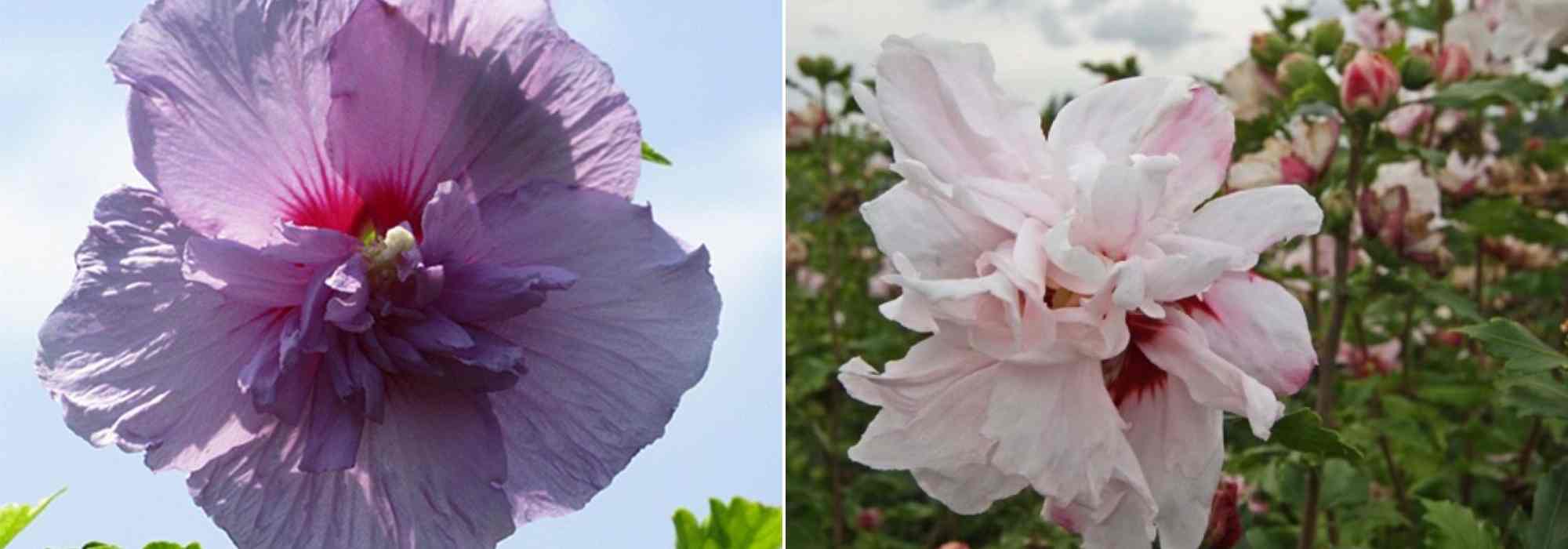
Hibiscus syriacus ‘Lavender Chiffon’ and ‘Leopoldii’
Large-flowered hibiscus
Marsh hibiscus (moscheutos) are generally the species offering the most impressive flowers in terms of size.
‘Cherry Cheesecake’ flowers from July to September with large white blooms tinged with pink, reaching up to 20 cm in diameter; hibiscus moscheutos ‘Rouge’, ‘Pink Passion’ and ‘Joli Coeur’ boast striking large flowers of 25 cm.
Among Hibiscus syriacus, ‘Rose Moon’ benefits from heritage of exotic parent paramutabilis to offer magnificent large 17 cm flowers.
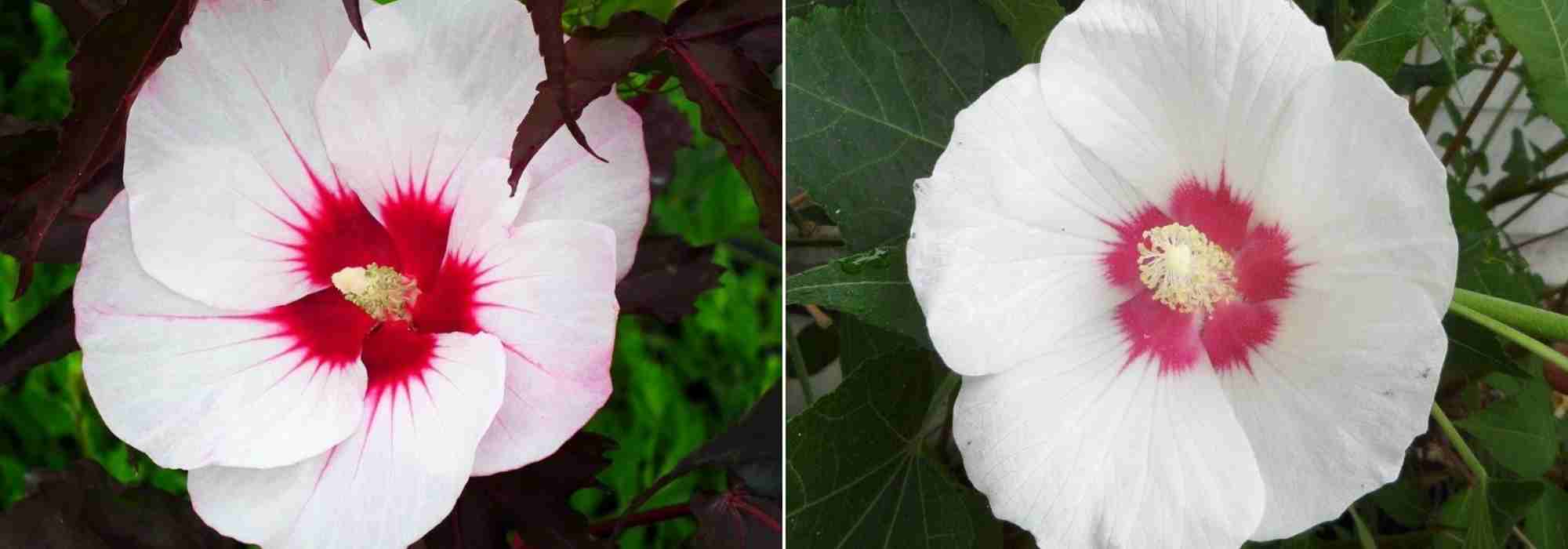
Hibiscus moscheutos ‘Joli Coeur’ and syriacus ‘Paramutabilis’
Discover other Hibiscus
View all →Available in 0 sizes
Available in 3 sizes
Available in 1 sizes
Available in 1 sizes
Available in 2 sizes
Available in 1 sizes
Available in 1 sizes
Available in 1 sizes
Available in 0 sizes
Available in 1 sizes
Depending on flowering period
Summer flowering of hibiscus usually starts in July and can continue until October. Some varieties, however, can produce early, late or remarkably long flowering.
Early-flowering hibiscus
As early as June, Hibiscus syriacus ‘French Cabaret Pastel’ displays its pretty double white-pink flowers, continuing through to end of summer.
Late-flowering hibiscus
Hibiscus ‘French Cabaret Purple’ and ‘French Cabaret Red’ offer fine late flowering from August to October, as do ‘Shintaeyang’ and ‘Woodbridge’.
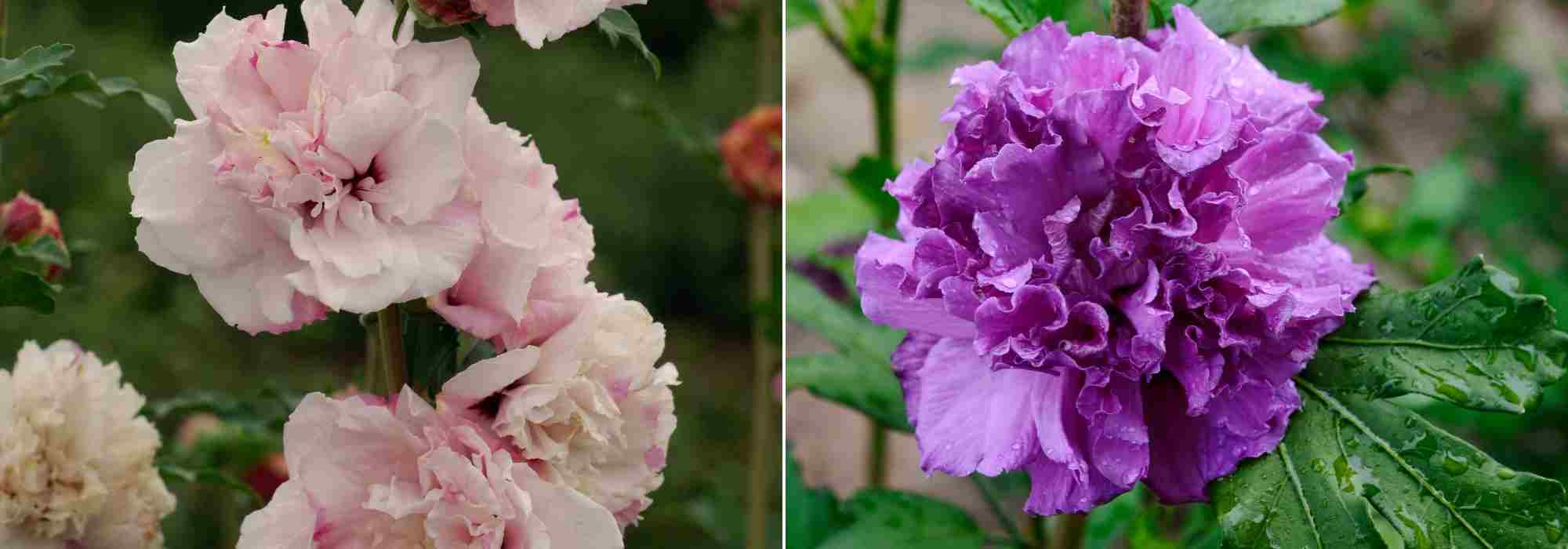
Hibiscus syriacus ‘French Cabaret Pastel’, early, and late ‘French Cabaret Purple’
Long flowering
Hibiscus with longest flowering renew their flowers continuously from July to October: this includes ‘Pink Giant’, ‘Eruption’, ‘French Point’, ‘Totus Albus’, ‘Purple Ruffles’ and ‘Eléonore’.
The marsh hibiscus ‘Fujin’ and hibiscus paramutabilis also have long flowering, lasting into autumn.
Read also
Growing a hibiscus in a potBy foliage
Hibiscus usually bear deciduous, simple, crenate leaves (with cut edges) in dark green tones. But some varieties offer even more decorative foliage :
- ‘Summer Ruffle’ displays a bright variegated foliage, bathed in cream and white on a grey-blue-green background, offering a superb contrast with its mauve flowers with a red throat;
- ‘Red Wine’ and its huge red flowers are set off by very deeply cut, particularly dark foliage, a purple tending towards black;
- ‘Midnight Marvel’, ‘Joli Cœur’, ‘Pink Passion’ and ‘Planet Griotte Tangri’ sport luxuriant foliage in purple tones.
- Hibiscus coccineus, already noted for the originality of its flower, also has finely cut foliage, reminiscent of hemp leaves or Japanese maple leaves.
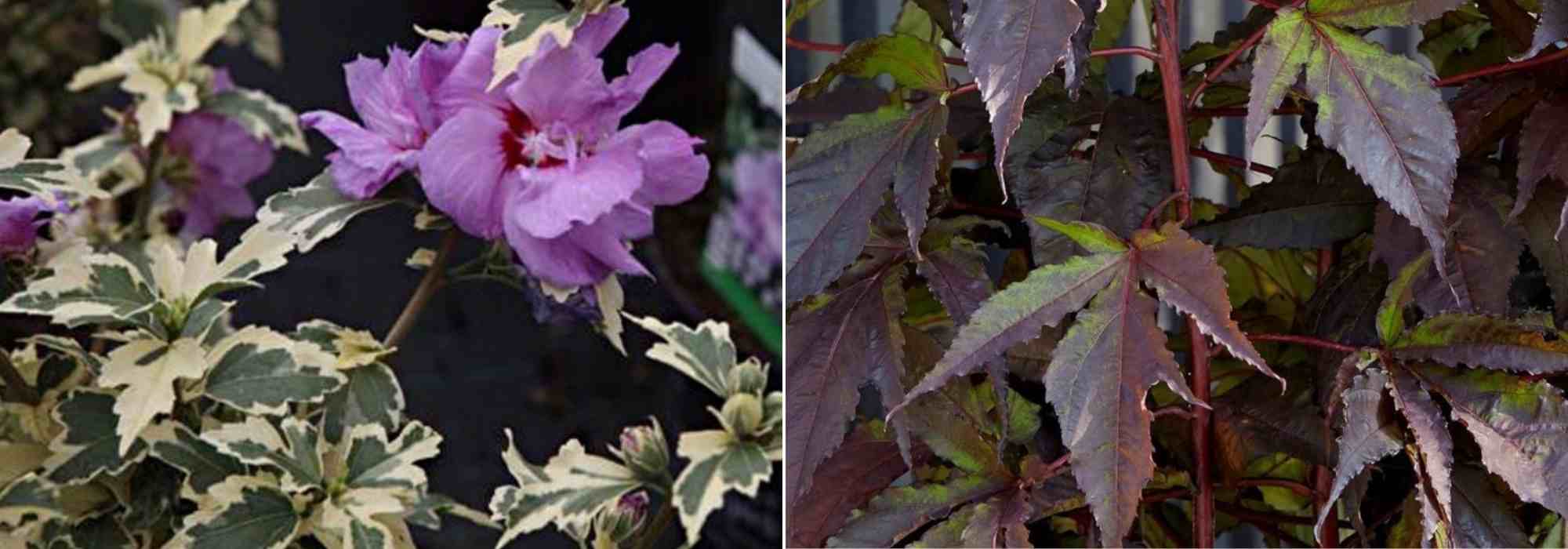
Hibiscus ‘Summer Ruffle’ and ‘Red Wine’
Depending on its pruning
If some hibiscus of modest sizes are well suited to growing in pots or small spaces, others reaching 3 or 4 metres in height with a 2-metre spread will create real flowering hedges, bringing an exotic touch both in borders and when planted singly.
Small varieties to grow in pots or small gardens
Whether for aesthetic reasons or to make wintering easier for less hardy varieties in regions with cold winters, growing hibiscus in pots poses no problem.
Ideally, choose the most compact, small varieties.
- Hibiscus syriacus ‘Freedom’ has slow growth and a compact habit that are well suited to small gardens and growing in pots.
- ‘Summer Ruffle’ with its upright, compact silhouette and small dimensions (1 m tall and 80 cm spread). It is perfect for dressing terraces and balconies.
- ‘Pink Passion’ and its magnificent large flowers will offer a real exotic display in a pot, thanks to a compact bushy habit and modest dimensions (1.2 m tall and 1 m spread).
- Slightly larger, Hibiscus coccineus (1.75 m with only a 50 cm spread) will not go unnoticed in a pot, with its huge, striking red flowers.
- Marsh hibiscus ‘Fujin’ is a dwarf variety of only 80 cm, ideal in a flowering container. This variety likes waterlogged soils, so its potting mix must be kept consistently moist throughout summer.
- Marsh hibiscus ‘Pink Candy’, ‘Joli Cœur’ and ‘Red Wine’ have a slightly more irregular habit, but are also suitable for pot culture to add a touch of colour to terraces and balconies. They measure only 1.2 m tall with a 1 m spread.
- In large containers, various ‘French Cabaret’ varieties, reaching up to 2 m high, will be well showcased.
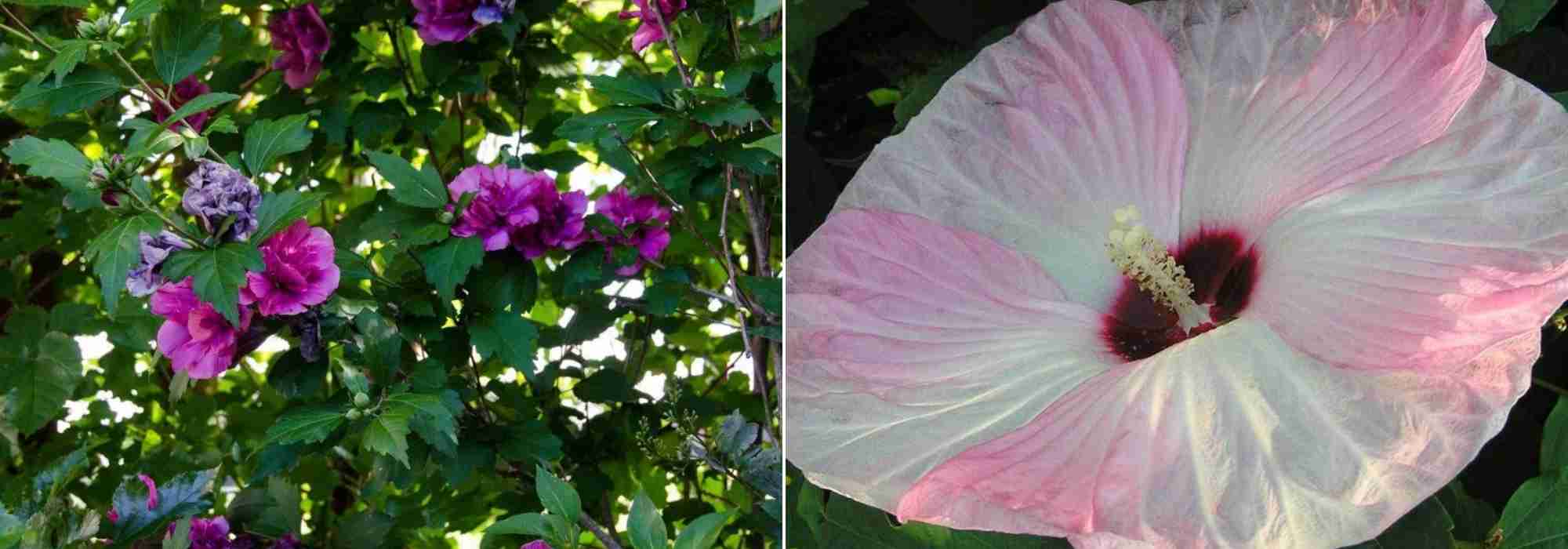
Hibiscus syriacus ‘Freedom’ and Hibiscus moscheutos ‘Fujin’
Larger varieties
For a spectacular flowering hedge and to dress large spaces, choose large-sized hibiscus :
- ‘Oiseau Bleu’ (3 m in height with a 2 m spread) ;
- Hibiscus paramutabilis (2.5 m tall and 2.5 m spread) ;
- ‘Rose Moon’ (2.75 m with a 1.8 m spread).
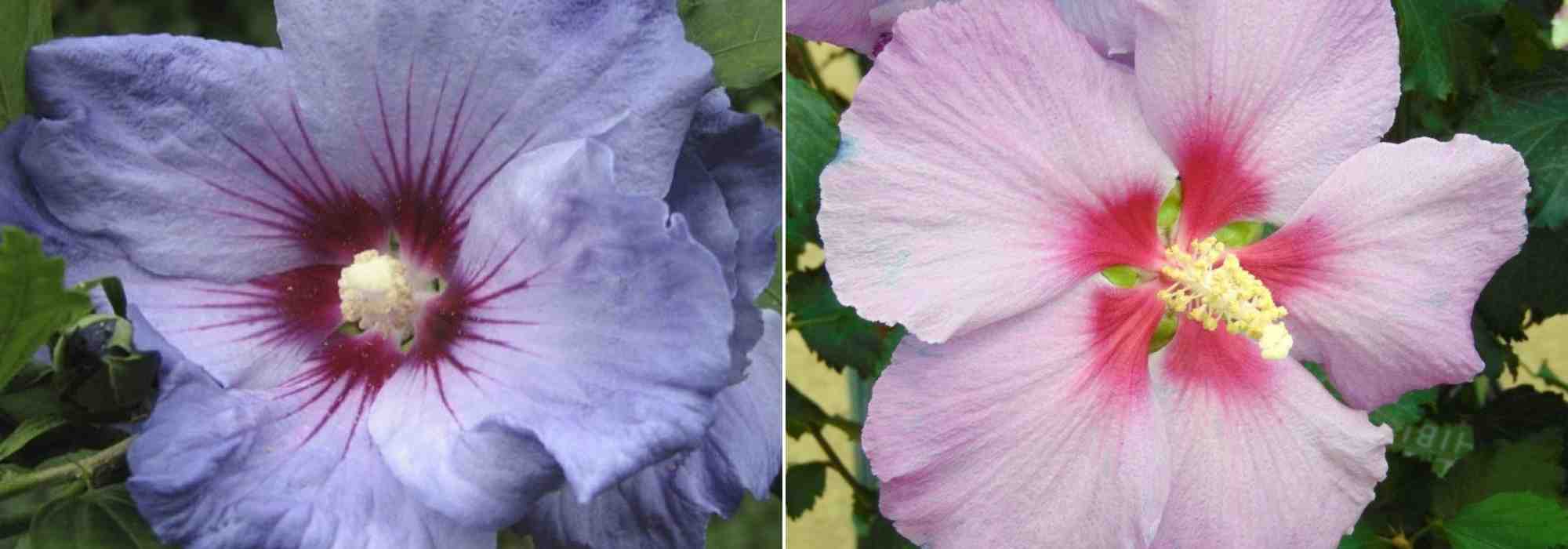
Hibiscus syriacus ‘Oiseau Bleu’ and ‘Rose Moon’
Depending on growing conditions
Hibiscus generally thrive in rich, rather clayey, well-drained soil and are watered regularly in summer. They are grown in a sunny position to promote good flowering.
But some varieties have their own specificities and will be suited to different conditions: cultivation with roots in water or in dry soil, cold-hardy varieties or indoor culture… You will therefore certainly find a variety of hibiscus suited to your soil, exposure or climate constraints.
Hibiscus for colder climates
Hibiscus of species syriacus tolerate winter frost in our regions and are hardy below -15°C. They can therefore remain in ground throughout winter, ideally with a good mulch at their base. Growth will then resume in spring, sometimes a little late, around May.
Same applies to rarer species paramutabilis, which tolerates down to -15°C and can be planted in all regions except mountainous areas or those with very harsh winters.
In regions with cool, wet summers, we recommend growing single-flowered varieties of hibiscus, which need less heat than double-flowered varieties to flourish.
Indoor hibiscus
Hibiscus rosa-sinensis or sabdariffa cannot be grown outdoors year-round at our latitudes, as they require a great deal of heat and sun and are very tender.
They should therefore be grown in pots, which can be placed outdoors during the warm season and must be brought indoors as soon as temperatures fall, around October.
In a room where temperature does not fall below 10–15°C, they can even continue to flower during winter.
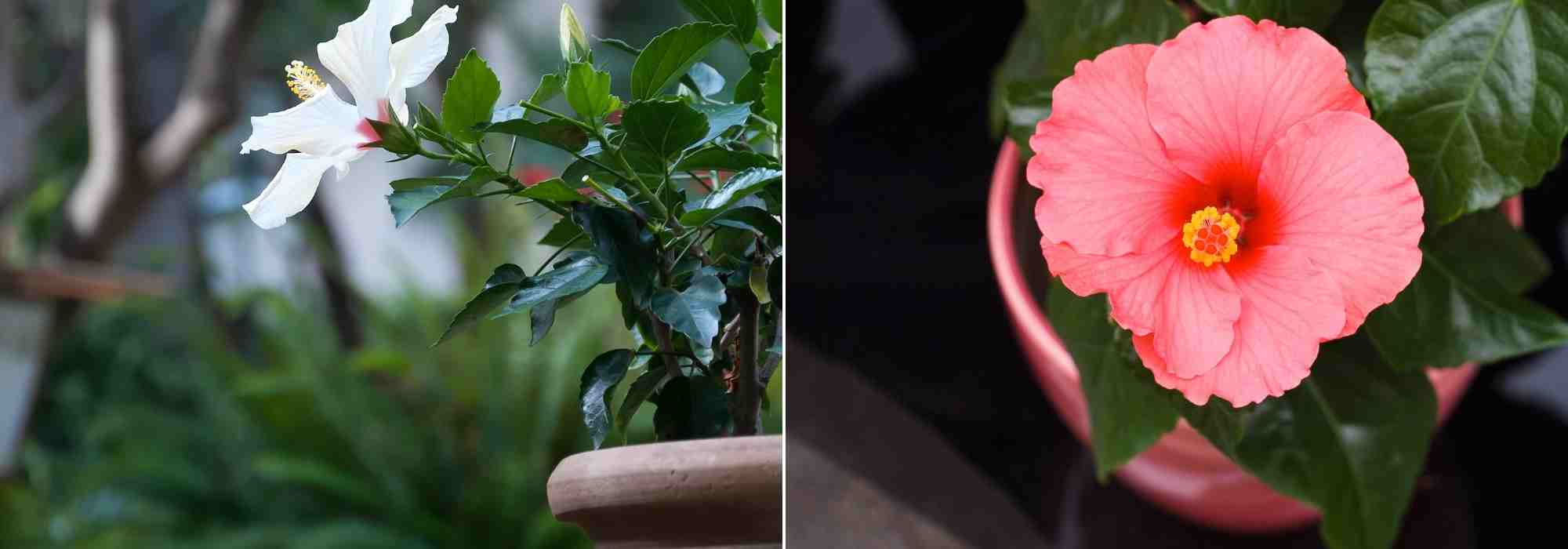
Hibiscus grown in pots
Hibiscus to grow in dry soil
While hibiscus tend to prefer cool soils in summer (retaining moisture), hibiscus trionum on the contrary thrives in dry, heat-exposed ground, grown as an annual.
It will form a small shrub barely 50 cm tall, revealing pretty cream flowers with a deep red, almost black, centre. Perfect as a specimen plant or in flowering hedges.
Hibiscus to grow in very wet soil
Marsh hibiscus (moscheutos) love having their roots in water, making them ideal candidates for water gardens, wetlands or pond margins, which their enormous flowers will immediately enhance.
Less hardy than their cousins, they cannot tolerate temperatures below -10°C. In mild regions of southern France, they can remain in ground, well protected and with a thick mulch at their base.
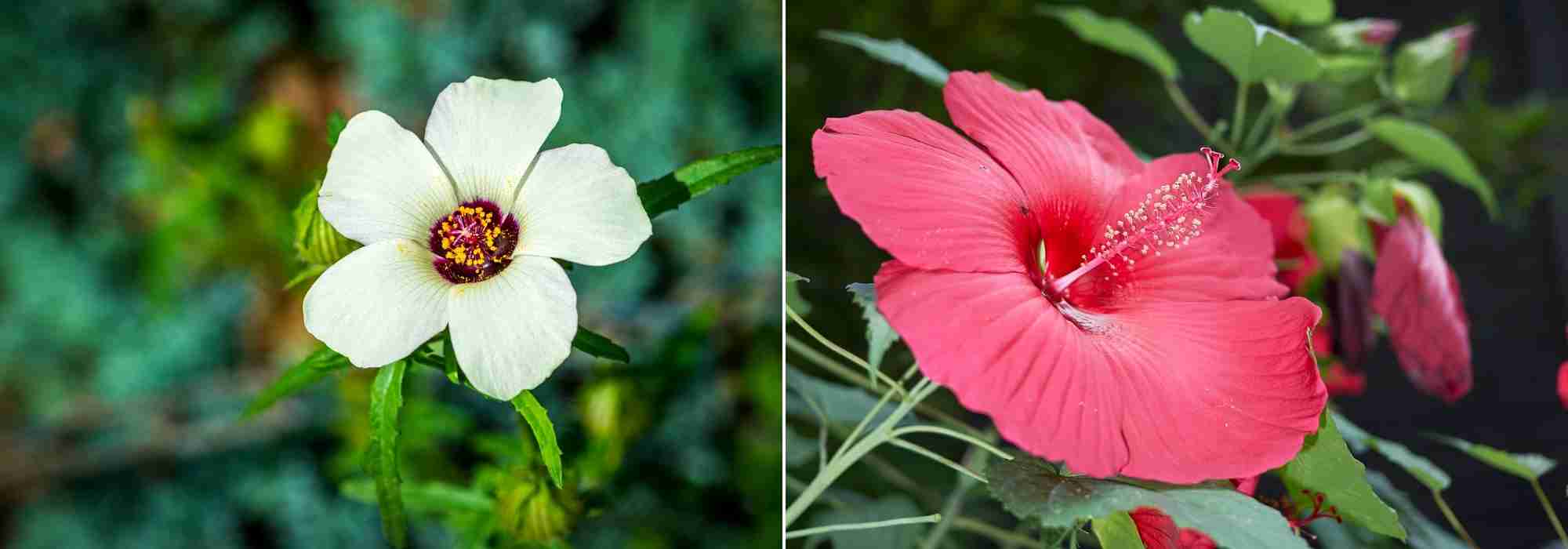
Hibiscus trionum and moscheutos
- Subscribe!
- Contents
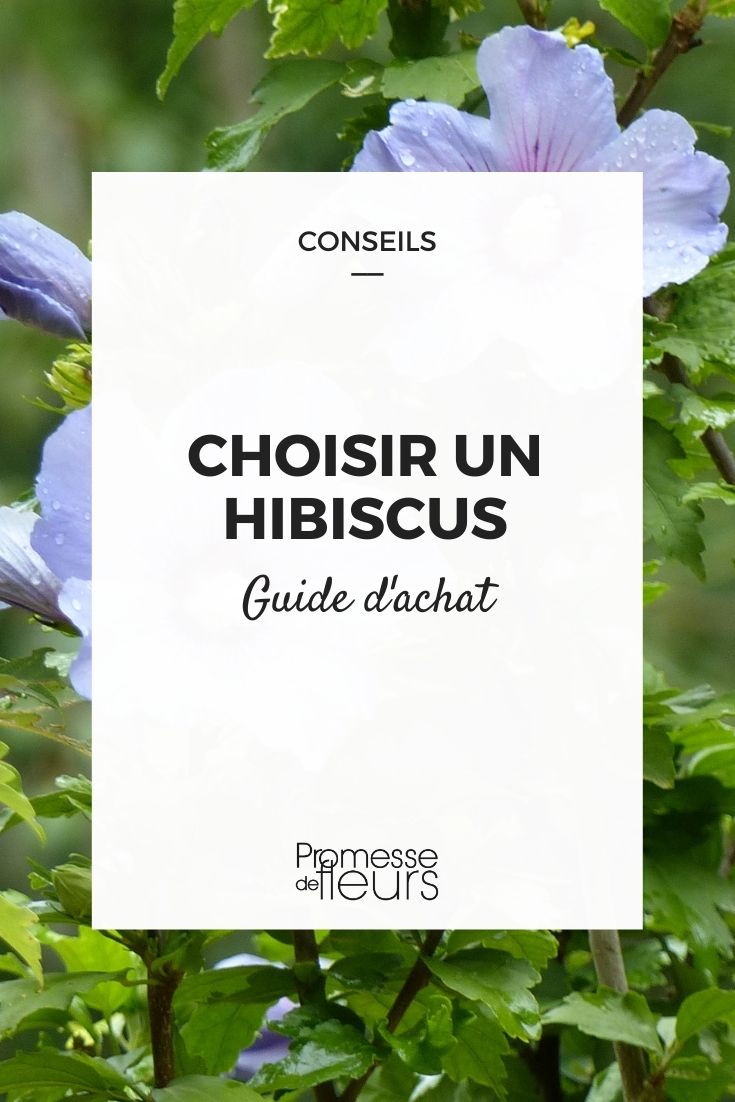































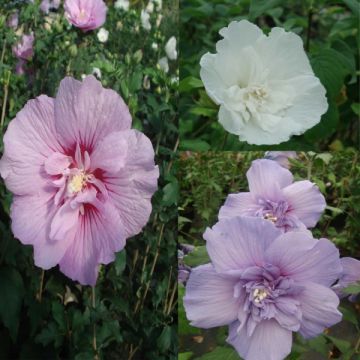
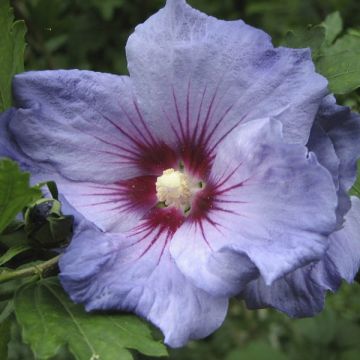
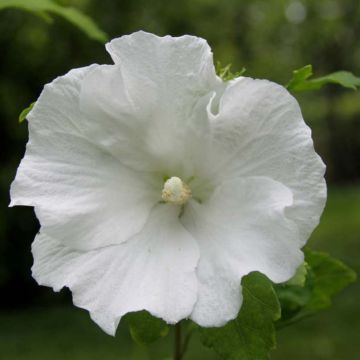
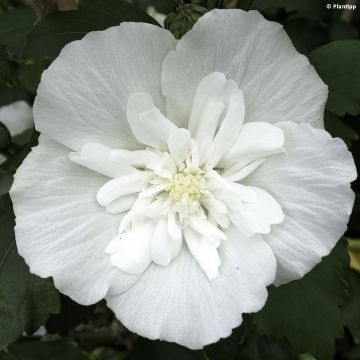
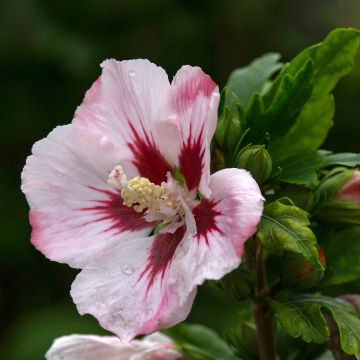
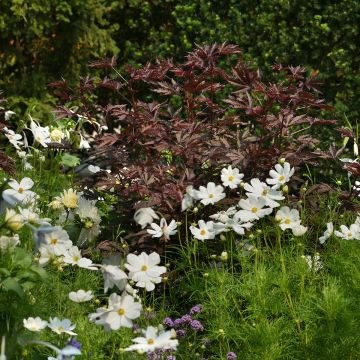
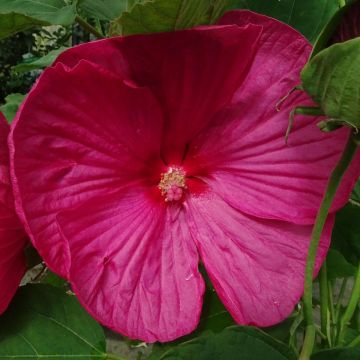
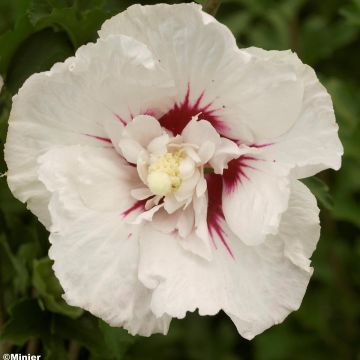
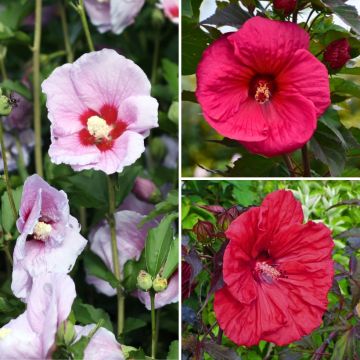
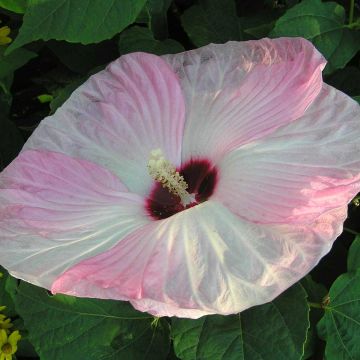
Comments